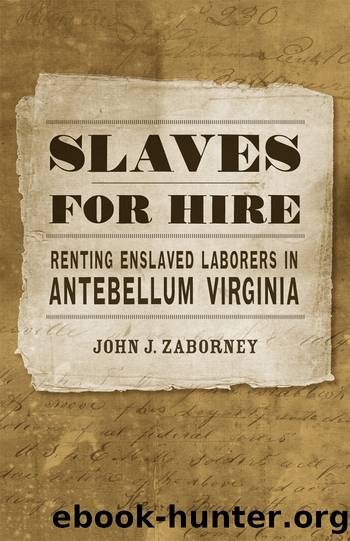Slaves for Hire by John J. Zaborney

Author:John J. Zaborney [Zaborney, John J.]
Language: eng
Format: epub
ISBN: 9780807145128
Barnesnoble:
Publisher: Louisiana State University Press
Published: 2012-10-12T00:00:00+00:00
CHAPTER 6
SLAVE HIRING, HIRED SLAVES, AND URBAN AND INDUSTRIAL SLAVERY
Because occupations in Virginiaâs cities and industries differed from those in agricultural and other settings, slave hiring was often different, too. Slave hiring also varied from one urban or industrial occupation to another in a multitude of ways. No one knew these things better than hired slaves themselves, because their labor had sustained Virginiaâs urban and industrial development since the eighteenth century.
Although it was not a new practice at the time, urban and industrial slave hiring became especially attractive during the Revolution, when Virginia Tidewater firms attached patriotism to plantersâ desire to rid themselves of excess slaves. In Fredericksburg, cloth manufacturers cried out to âGentlemen . . . friends of their countryâ to hire them âa few of their supernumerary little negroes [and thereby] rid themselves of that charge.â âNegroes [hired to us] are boarded and clothed clear of expenseâ and âin a decent manner,â the manufacturers assured planters. Elsewhere, revolutionary Virginia hired plantersâ extra slaves to produce cannon for the war. Some thirty hired slaves labored at the Westham Foundry in 1777, and a 1781 list included thirteen âNegroes hired by Order of the Governor.â1
Slave hiring for war-related industrial work in Virginia was a precedent for the private employment of hired slaves in industry during the Revolution and afterward. Ironmaster David Ross, for example, had acquired his Oxford Iron Works, located a few miles from Lynchburg, during the Revolution. From the outset, the relatively high cost and the possibility of strikes made Ross disinclined to hire white workers, so he looked to slave labor to fill his initial needs, as well as to serve his plans for the expansion of his operation. In 1777 Ross advertised in the Virginia Gazette for â50 or 60 Negro men for one, two, or three Years.â Because he anticipated Virginia slave ownersâ concerns about the welfare of their slave property, Ross assured them, âThe situation of [the] Works is very healthy, the Labour of the Slaves moderate, and they shall have a plentiful diet.â Ross further offered âan advance Price for Carpenters and Wheelwrights,â but he refused to âbe concerned with any that are noted Runaways.â Clifton Forge and Lucy Selina Furnace employed 90 slaves in 1827, and 70 slaves were working at Bath Iron Works. Meanwhile, smaller iron operations, especially in Botetourt, Page, and Wythe counties, hired slaves regularly. In Rockbridge County, Buffalo Forge had 114 slaves in its employ in 1840, and by 1851, 2,812 slaves were working at iron production in Botetourt County alone, with hundreds more also making iron throughout Appalachian Virginia.2
Other Virginia industrialists also were impressed by the usefulness of hired slaves in wartime production. In 1782 the governor of Virginia was informed that slave rope makers, idle since the end of the war and the burning of the state rope walks, âcould be hired out to advantage . . . [because] the proprietors of the private rope-walks near Richmond [were] very anxious to hire these negroes and [would] give high wages for them.
Download
This site does not store any files on its server. We only index and link to content provided by other sites. Please contact the content providers to delete copyright contents if any and email us, we'll remove relevant links or contents immediately.
In Cold Blood by Truman Capote(3311)
The Innovators: How a Group of Hackers, Geniuses, and Geeks Created the Digital Revolution by Walter Isaacson(2848)
Steve Jobs by Walter Isaacson(2836)
All the President's Men by Carl Bernstein & Bob Woodward(2329)
Lonely Planet New York City by Lonely Planet(2172)
And the Band Played On by Randy Shilts(2131)
The Room Where It Happened by John Bolton;(2105)
The Poisoner's Handbook by Deborah Blum(2093)
The Murder of Marilyn Monroe by Jay Margolis(2059)
The Innovators by Walter Isaacson(2056)
Lincoln by David Herbert Donald(1945)
A Colony in a Nation by Chris Hayes(1881)
Under the Banner of Heaven: A Story of Violent Faith by Jon Krakauer(1750)
Amelia Earhart by Doris L. Rich(1650)
The Unsettlers by Mark Sundeen(1647)
Being George Washington by Beck Glenn(1623)
Birdmen by Lawrence Goldstone(1621)
Dirt by Bill Buford(1612)
Zeitoun by Dave Eggers(1593)
